
Technique Toolbox: Increase the Speed of Your Adjustment
By John Minardi BHK DC
Features Clinical TechniquesA 35-year-old construction worker enters the clinic complaining of low back pain.
Sample Case
A 35-year-old construction worker enters the clinic complaining of low back pain. The patient informs the doctor that the problem has been intermittent for the past 10 years, ever since he began construction work, and has steadily become worse over the past two years. He relays to the doctor that he has been to chiropractors in the past, but that many of those had a hard time adjusting him due to his larger frame. Physical examination reveals a decreased lumbar range of motion in the extended position. Lumbar extension also reproduces the pain at its end range. Static and motion palpation reveal subluxations present at L4 and L5 on the right, with subsequent hypertonicity of the quadratus lumborum bilaterally. Neurological and X-ray analyses are unremarkable. The doctor is proficient in manual adjusting techniques, and is confident that (s)he will be able to effectively adjust the patient’s subluxations, regardless of the individual’s size. The doctor promptly places the patient in a side posture position and attempts to adjust the subluxated lumbar vertebrae. However, as the doctor takes his contacts, he notices that the individual’s frame has altered the doctor’s contact positioning, and finds it difficult to roll the patient into the proper thrusting position. Once the position is finally achieved, the doctor realizes that his thrust seems slow and weak for this patient, resulting in a sub-par adjustment.
Has this ever happened to you? Have you ever had a difficult time adjusting a patient, or just felt as though your thrust lacked a certain speed or power? In this edition of Technique Toolbox, I will review two activities that will help develop a faster thrust, by implementing exercises that increase the recruitment of your “fast twitch” muscle fibres.
Muscle Fibre Types
There are three main types of muscle fibres. Each one has its own characteristics and is suited to a particular type of movement.
Type I muscle fibres: These muscle fibres contract slowly (slow twitch), and can sustain muscular contractions for an extended period of time. This makes them ideal for endurance type of events. They contain large and numerous mitochondria, which aid in their oxidative metabolism. These fibres do not fatigue quickly; however, they are only able to produce a low level of force output.1
Type IIa muscle fibres: These muscle fibres are named fast twitch fibres. However, they are in the middle of the muscle fibre spectrum, as they are less fatigue resistant, produce more muscular force, and contract at a faster speed than slow twitch fibres, but not quite as much as Type IIb fibres.1
The Type IIb muscle fibres: These muscle fibres are the most easily fatigued out of all the fibres, but also generate the most power. These are most heavily recruited for activities that require a large burst of power over a very short period of time.1
These Type IIb muscle fibres are the fibres primarily recruited for your thrust. (Type IIa muscle fibres also play a small role.) Therefore, when conditioning to improve the speed of your thrust, it is the Type II muscle fibres, mostly ‘b’ but also ‘a’, that you should be targeting with your training.
So, how do we recruit more of these Type II muscle fibres to produce a more effective thrust? The simplest way is to perform plyometric exercises that target the employment of the pectoralis and triceps muscles, the same muscles recruited in most chiropractic adjustments.
Exercise 1:
Depth Push-Ups (See photos 1-3)
- Start in a “push-up” position with both arms in full extension, and both hands placed on a medicine ball (or wooden block).
- Quickly drop both hands out and away from the medicine ball, forcing your body to free-fall
- toward the ground.
- Once your hands touch the ground your arms will bend slightly from the impact.
- As soon as the impact occurs, push up from the ground with an explosive force, so that your hands land back on top of the medicine ball, and your body is back in the push-up starting position.
- Repeat eight to 10 reps.
- Rest for one minute.
- Repeat for three sets.
Exercise 2:
Drop and Catch Push-Ups on an Exercise Ball (See photos 4-6)
- Start in a push-up position with both arms in full extension, and both hands placed on a giant exercise ball.
- Quickly drop both hands out and away from the exercise ball, forcing your body to free-fall toward the ball.
- Allow your chest and abdomen to bounce on top of the ball.
- Once your body begins to bounce back up from the collision with the ball, bring both hands in to quickly stabilize the ball. Simultaneously, push up from the ball with an explosive force so that your hands are on top of the ball, and you are back in the push-up starting position.
- Repeat eight to 10 reps.
- Rest for one minute.
- Repeat for three sets.
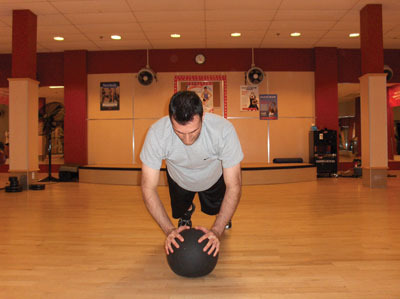 |
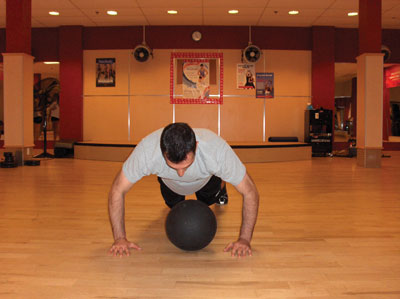
|
| Photo 1: Start with hands are on top of a medicine ball, while body is in a “Push-Up” position.
|
Photo 2: Quickly drop both hands out and away from the medicine ball, forcing your body to free fall toward the ground. Once your hands touch the ground your arms will slightly bend from the impact. |
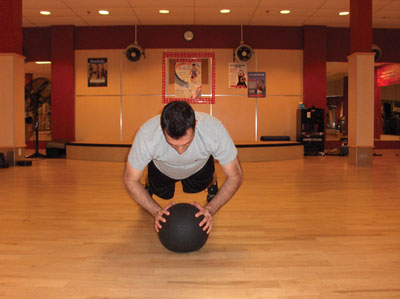 |
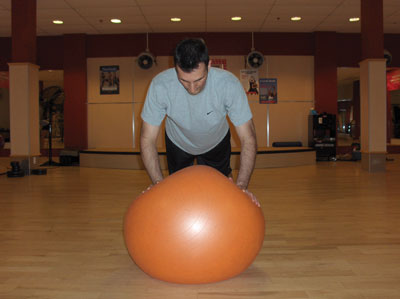 |
| Photo 3: As soon as the impact occurs, push up from the ground with an explosive force, so that your hands land back on top of the medicine ball, and your body is back in the “Push-Up” starting position. | Photo 4: Start in a “Push-Up” position with both arms in full extension, and both hands placed on a Giant Exercise Ball.
|
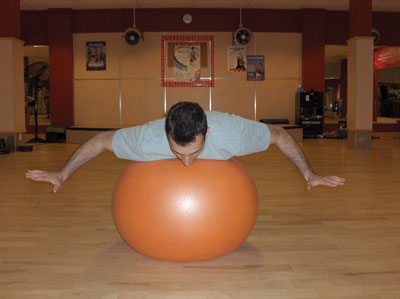 |
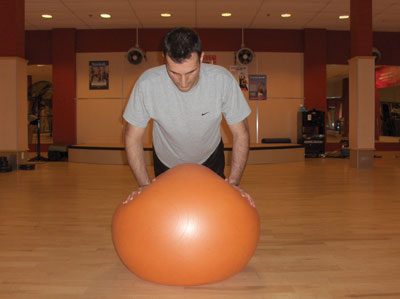 |
| Photo 5: Quickly drop both hands out and away from the Exercise Ball, forcing your body to free fall toward the ball. Allow your chest and abdomen to bounce on top of the ball.
|
Photo 6: Once your body begins to bounce back up from the collision with the ball, bring both hands in to quickly stabilize the ball. Simultaneously, push up from the ball with an explosive force so that you are back in the “Push-Up” starting position.
|
Keep in mind, with each of these exercises, that the idea is to create a short, explosive burst, not a deep contraction. These forms of activities send a clear message to the brain. That message is that the body must adapt to create force quickly, both neurologically and metabolically.2 Remember, we are trying to recruit as many Type II motor units as possible, in the
shortest time frame, to create the high velocity needed in a chiropractic adjustment.
It should also be mentioned that exercise 2 is more advanced than exercise 1 – be sure that exercise 1 is mastered before moving on to exercise 2.
By incorporating these exercises as part of your overall fitness regimen, you can develop a quick and explosive thrust to effectively adjust anyone.
As usual, I have only scratched the surface regarding these plyometric activities. To learn more about these types of exercises and how to recruit more Type II muscle fibres, please go to www.bodybuilding.com. If you have any questions, please
e-mail me at johnminardi@hotmail.com.
Until next time . . . Adjust with confidence! •
References
- Woodrup, J. Fast twitch training. 2008. www.verticaljumping.com/fast_twitch.html
- Baggett, K. Becoming a fast twitch
- machine. 2009. www.bodybuilding.com
Dr. John Minardi is a 2001 graduate of Canadian Memorial Chiropractic
College. A Thompson-certified practitioner and instructor, he is the
creator of the Thompson Technique Seminar Series and author of The
Complete Thompson Textbook – Minardi Integrated Systems. In addition to
his busy lecture schedule, Dr. Minardi operates a successful private
practice in Oakville, Ontario. E-mail: johnminardi@hotmail.com, or visit
www.ThompsonChiropracticTechnique.com.
Print this page